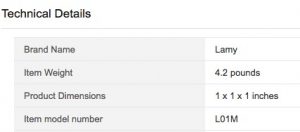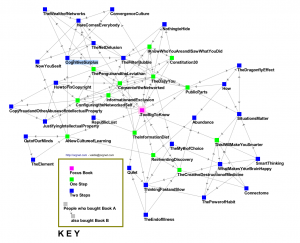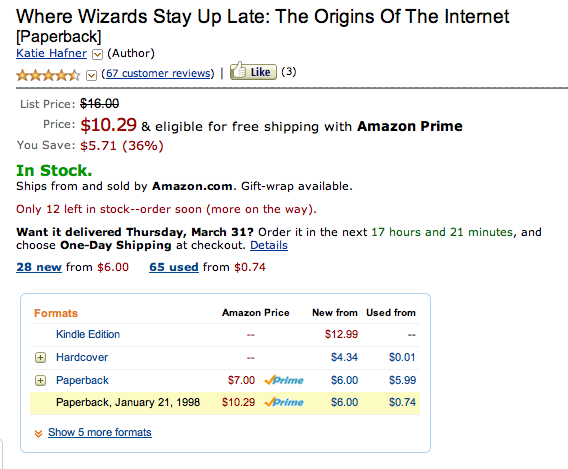March 22, 2017

Speaker info
July 7, 2015
Friends reviewing friends
Amazon is refusing to post reviews when its algorithms sense a personal relationship between the author and the reviewer. Amazon says, “We are removing your reviews because you know the author personally,” according to Chris Morran at The Consumerist.
The intent is fine. A review is likely to be swayed by a personal friendship. That’s why some of us disclose friendships when posting reviews at Amazon.
But, it would help if Amazon clarified what “knowing an author personally” means. In a networked world, that is an incredibly vague description.
After that, here are some suggestions that I think would help matters while preserving the policy’s good intentions:
1. Flag reviews by people with personal relationships, but don’t remove them. They may in fact shed special light on the work being reviewed.
2. Allow reviewers to flag their own reviews, and to describe their relationships. E.g., “We are colleagues,” “She’s a lifelong friend,” “We were close friends until I moved 12 yrs ago,” “We’ve been on panels together,” “We were friends until the lying bastard done me wrong.”
3. Do not count the ratings by such people in the overall total.
4. Provide some avenue of appeal when the algorithm goes wrong.
April 14, 2012
[2b2k] Too Big to Know’s network
Valdis Krebs has posted a map of books that Amazon says people who bought 2b2k also bought, and then the web of books that are one degree away from those books.
It’s interesting to parse as you try to discern what the shared interests are. And I’m surprised that Amazon hasn’t picked up on it as a way to sell more books, and that publishers haven’t picked up on it to understand their market better.
In any case, thanks, Valdis!
February 25, 2012
[2b2k] Mr. Bezos’ Neighborhood
Valids Krebs put together a map of the “people who bought this also bought that” neighborhood at Amazon for Too Big to Know:
It’s interesting to me to see the direct links to works on the same topic (e.g., Reinventing Discovery), some indirect links to works on closely related topics (e.g., The Filter Bubble), and some direct links to topics within the more general field of “about the Internet” (Consent of the Networked, Public Parts). I have no conclusions to offer. Just interest.
September 28, 2011
C.lient-surfer
Amazon’s pitch for its new Silk Browser describes a client-server architecture from the 1980s applied to the Net. In 1995, when I was VP Marketing at Open Text (1995-6), I tried to get the company to describe the architecture of its Web-based collaborative tools as Client-Surfer.
I’ve been waiting 16 years to re-introduce that pun. Is now the time?
April 23, 2011
How the robots bid a book up to $23,000,000 at Amazon
Michael Eisen has a terrific post in which he does the detective work to figure out how dueling algorithms from two competing bookstores drove the price of a book about flies up to $23,698,655.93.
I’m sorry that some human noticed and backed the prices down. I would have liked to have seen a financial bubble form as the price went into the trillions.
March 30, 2011
July 28, 2009
Annals of openness in peril
1. The court has rejected Charlie Nesson’s basic defense of Joel Tenenbaum’s sharing of music files. The case is going to jury which may levy the same sort of insanely excessive fines as in the Jammie Thomas-Rassert trial. I hope Charlie’s team can convince the jury that the fines and the entire process are so onerous and disproportionate that the RIAA has been abusing the court system. Of course, IANAL, and IANAOTJ (I am not on the jury).
2. Barnes and Noble has launched its e-book software. It runs on iPhones as well as on PC’s and Mac’s. I’m having trouble finding which formats it supports, but judging from its Open dialogue, not PDF, .doc, .html, .mobi, or text. It does support .PBD books.
After a very very quick session playing with it, it seems quite competitive with the Kindle, and because I’m running it on my Mac and not on the little piece of crippled hardware I bought from Amazon — the Kindle is just barely adequate as a reader, and is still overpriced by more than 100% in terms of its value, imo — having the use of a keyboard and a mouse is a big step up. And, unlike the Kindle, you can use whatever fonts you have on your machine. Still, it’s only incrementally better than the Kindle’s software (again, on a quick look), not a great leap forward for readers.
One of B&N’s big advantages is that it’s hooked into Google Books, enabling you to download public domain books that Google has scanned in. You do this by searching for a book on the B&N site and noticing the “free from Google Books” label. Be sure to sort by price; otherwise B&N lists the for-pay versions first. If B&N wants to be aggressive in this space (= succeed), it should create an easy-to-find section that lets you browse Google’s free books. Get us using the ereader and then sell us the copyrighted books. (If B&N has such a section, I couldn’t find it quickly enough.)
BTW, I presume (and thus may be wrong) that Google did a special deal with B&N to enable this. If so, I find it worrisome. If Google is going to be granted a special right to scan in books without fear of copyright reprisals, it will be the de facto national e-library, discouraging others from undertaking similarly scaled scanning projects, and thus should be making its public domain books equally and maximally freely available. IMO.
2a. [Later that evening:] B&N stores are now providing free Wifi. Yay!
3. Apple is not permitting the Google telephone service into the Apple App store, thus simultaneously and inadvertently making the case for Zittrainian generativity.
4. [Later that day]: On the happy front, Google has open-sourced an implementation of Wave.
July 17, 2009
The strongest force in the universe continues to be irony
David Pogue reports that Amazon has deleted some books from people’s Kindles, even though people had paid for them. It seems that the publisher decided it didn’t want them offered after all. [NEXT DAY: More exactly, the publisher that owns the copyright objected to another publisher selling the book.] So, Amazon deleted the books and credited people for their purchase.
The books were George Orwell’s Animal Farm and 1984. OMG.
June 20, 2009
If Amazon ran the schools
In my endless ego surfing, trying to fill an emptiness for which no number of trackbacks can suffice, I came across a posting about Everything Is Miscellaneous on the TWelchConsulting blog. Towards the end, the post says:
Imagine after Maria mastered that formula, this message appeared on her computer screen: “Maria, learners who enjoyed solving equations about one dimensional motion in physics with examples from space science also enjoyed . . . “
Sort of a cool idea…











